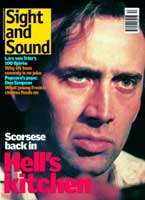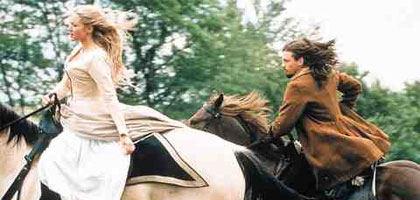
Gone with the wounded
Film of the Month: Ride with the Devil

Ride with the Devil, Ang Lee's follow-up to The Ice Storm, may be painted with broader strokes than his earlier work, but it still confirms that he's a masterly and most mysterious talent, argues Peter Matthews
Unless one is charitable enough to include a piece of mega-shlock like Titanic in the reckoning, Hollywood has pretty much given up on historical spectacle these days. Since the studios are happy to stake imperial sums on the latest sci-fi or action-adventure franchise, the reasons can't be strictly budgetary. The thinking probably is that teenagers at the shopping mall lack the rudimentary knowledge required to empathise with people from the past. When Gone with the Wind was released back in 1939, most filmgoers could be trusted to have the rough co-ordinates of the ante-bellum and Reconstruction eras stored in their brains, but that may no longer be the case. (To be fair, in 1939 some viewers in their eighties may even have lived through the war.) In any event, projects with too culturally specific a flavour are far less apt to be green-lighted now that global saturation has become the industry rule.
In this dual context of popular ignorance and corporate greed, Universal Studios is to be congratulated for having the altruism, the courage or maybe just the plumb foolhardiness to underwrite director Ang Lee's Civil War drama Ride with the Devil. While the movie intermittently revs up for some showy combat scenes, its real métier is a texture of fine-grained observation that brings history to life on the molecular level. Lee's famed attention to detail isn't necessarily the most lucrative quality in box-office terms, however, and there are bound to be many viewers who find his meditative rhythms a tax on their patience.
I wouldn't entirely disagree, but I think the movie is to be honoured more for its risk-taking longueurs than for the conspicuous ruckus of its action sequences. The Taiwanese-born Lee is almost invariably described as a consummate miniaturist and it's understandable that he should wish to knock that orientalist assumption on its head. In Ride with the Devil he exhibits a gift for raw brutality which couldn't have been guessed at from such sunnier entertainments as The Wedding Banquet (1993) and Sense and Sensibility (1995) - or even from the psychological violence of his sombre masterpiece The Ice Storm (1997). The current film can boast one hideous amputation plus an assortment of gaping war wounds, and it culminates in a civic massacre that seems a deliberate nod to the opening bloodbath of Sam Peckinpah's The Wild Bunch (1969). Maybe Lee needed to beat his chest a little for the benefit of those studio powerbrokers who would forever typecast him as a purveyor of dainty chinoiserie. But he also knows this virile posturing is basically kids' stuff - just like the heroic swagger of the young guns whose story he tells.
It's no great mystery what attracted Lee and screenwriter-producer James Schamus to the source material, Daniel Woodrell's acclaimed 1987 novel Woe to Live On. Set along the border of Kansas and Missouri in the 1860s, the book rehearses an eerily familiar scenario of neighbour squaring off against neighbour in a mortal struggle over value and belief. There's more than a suggestion of such other historic trouble spots as Northern Ireland, Kosovo and Vietnam in Woodrell's depiction of an internecine strife whose cruelty intensifies as longstanding private vendettas get hopelessly tangled with ideology. It's the same order of domestic dysfunction Lee and Schamus have treated in all their films, only this time written larger and in letters of blood.
Much has already been made of the fact that the movie adopts the perspective of the American South - identifying not with its racism, certainly, but with the core of aggrieved humanity lying behind that culture. Actually, most Civil War pictures are from the Confederate point of view, for the obvious reason that gallant, gracious and vanquished Dixieland offers better opportunities for pictorial elegy than the victorious North. If Lee feels a twinge of closet sympathy for the Southerners, it's doubtless because they embody a vital connection to tradition which the secular and forward-looking Yankees have lost.
Lee's earlier, family-based dramas were scrupulously poised between celebrating and chastising our modernity for its loosening of the ties that bind. The Ice Storm appeared to tip the scale towards conservatism, but even there the suburban wife-swappers were made human and comprehensible in their fumbling attempts at self-emancipation. Ride with the Devil simply extends this principled ambiguity to a broader canvas.
In one sense, the movie is about throwing off the bad old customs and acquiring the virtues of liberal democracy. Desperate to prove his mettle, second-generation foreigner Jake Roedel (Tobey Maguire) joins in the slaughter of Union troops by the marauding Confederate guerrillas, the Bushwhackers, until enlightenment dawns in the guise of former slave Daniel Holt (Jeffrey Wright), whom he learns to accept on an equal footing with himself. Holt, meanwhile (who has sided against his own interests out of misguided loyalty to his quondam master), discovers the sweet taste of freedom. A third object lesson is supplied in the person of Sue Lee Shelley (Jewel), feisty frontierswoman and standard-bearer of the proto-feminist cause. However, the rise of egalitarian values also means the defeat of a whole way of life founded on their denial. That's the lacerating irony at the heart of both book and film. The flower of liberty is gained through an act of conquest, thus setting in train primordial resentments that continue to fester today (the 'woe to live on' of Woodrell's punning title).
D. W. Griffith similarly recognised that the steamrollering of the Confederacy was the necessary condition for the birth of a nation. But in his blighted 1915 epic of that name he had the demoralised South rear up again proudly through the fairytale expedient of the Ku Klux Klan. Not surprisingly, Lee and Schamus give their own pack of roving vigilantes a wider berth. The Bushwhackers aren't begrudged a glamorous aura as they gallop over the countryside, buckshot blazing and unkempt tresses flowing in the breeze. Yet at the same time they are regarded as atavistic specimens whom the film-makers would sternly admonish to grow up and get a haircut. Jake does in fact have that tonsorial operation performed on him in an emblematic scene, thereby acknowledging his conversion to civilised norms. In still another symbolically charged moment his shot-off pinkie finger becomes an impromptu nipple for a baby to suck on.
There is sure to be some clever queer critic who argues that our hero's eventual repudiation of the masculine bond and pacification by marriage express a rearguard political agenda. But that's just a fancy way of saying this is a classical Western, plumping itself at the crossroads between phallic lawlessness and feminised order almost by definition. Ride with the Devil wants the precise sensibility of Lee's best work (the logistics of mounting a super-production having thickened his brushstrokes somewhat). Still, there remain countless ineffable grace notes - the primeval greenness of woods in the midst of carnage or a fidelity to the autumnal crispness of a particular day - that amply confirm this director as the most mysterious talent at large in American cinema.
